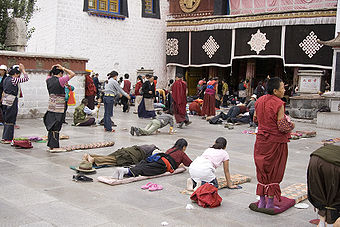- Monlam Prayer Festival
-
Monlam Tibetan name Tibetan: སྨོན་ལམ་ Wylie transliteration: Smon-lam Part of a series on Tibetan Buddhism
History Timeline · Related-topics Schools Nyingma · Kagyu · Sakya · Gelug · Bön · Jonang Key concepts Three marks of existence · Skandha · Cosmology · Saṃsāra · Rebirth · Bodhisattva · Dharma · Dependent origination · Karma Major figures Gautama Buddha · Padmasambhava · Je Tsongkhapa · Dalai Lama · Panchen Lama · Lama · Karmapa Lama · Rinpoche · Geshe · Terton · Tulku Buddhahood · Avalokiteśvara · Four stages of enlightenment · Tantric yoga · Paramitas · Meditation · Laity Changzhug · Drepung · Dzogchen · Ganden · Jokhang · Kumbum · Labrang · Mindroling · Namgyal · Narthang · Nechung · Pabonka · Palcho · Ralung · Ramoche · Sakya · Sanga · Sera · Shalu · Tashilhunpo · Tsurphu · Yerpa Chotrul Duchen · Dajyur · Losar · Monlam · Sho Dun Texts Kangyur · Tengyur · Tibetan canon · Mahayana sutras · Nyingma Gyubum Sand mandala · Thangka · Ashtamangala · Tree of physiology Outline · Comparative studies · Culture · List of topics · Portal
Monlam also known as The Great Prayer Festival, falls on 4th -11th day of the 1st Tibetan month in Tibetan Buddhism. The event in Tibet was established in 1409 by Tsong Khapa, the founder of the Geluk tradition. As the greatest religious festival in Tibet, thousands of monks (of the three main monasteries of Drepung, Sera and Ganden) gathered for chanting prayers and performing religious rituals at the Jokhang Temple in Lhasa.
In 1517, Gedun Gyatso became the abbot of Drepung monastery and in the following year, he revived the Monlam Chenmo, the Great Prayer Festival and presided over the events with monks from Sera, Drepung and Gaden, the three great monastic Universities of the Gelugpa Sect.[1]
"The main purpose of the Great Prayer Festival is to pray for the long life of all the holy Gurus of all traditions, for the survival and spreading of the Dharma in the minds of all sentient beings, and for world peace. The communal prayers, offered with strong faith and devotion, help to overcome obstacles to peace and generate conducive conditions for everyone to live in harmony."[2]
Examinations for the highest 'Lharampa Geshe' degree (a degree in Buddhist philosophy in the Geluk tradition) were held during the week-long festival. Monks would perform traditional Tibetan Buddhist dances (cham) and huge ritual offering cakes (tormas) were made, that were adorned with very elaborate butter sculptures. On the fifteenth day the highlight of Monlam Chenmo in Lhasa would be the "Butter Lamp Festival" (Chunga Chopa), during which the Dalai Lama would come to the Jokhang Temple and perform the great Buddhist service. Barkhor Square in front of the Jokhang would be turned into a grand exhibition site for the huge tormas. At the end of the festival, these tormas would be burned in a large bon-fire.
Traditionally, from New Year's Day until the end of 'Monlam', lay Tibetans would make merry. Many pilgrims from all over Tibet would join the prayers and teachings, and make donations to the monks and nuns.
Many other monasteries would hold special prayer sessions and perform religious rituals, for example some monasteries would unfold huge religious scroll-paintings (thangkas) for all to see.
During the Cultural Revolution, the Monlam festival was banned, and although it was revived once in 1985, it was prohibited again in 1990 by the Chinese government.
In the newly established Tibetan Buddhist monasteries in India, the monlam festival is gradually being revived.
See also
References
- ^ Staff. "The Dalai Lamas - The Office of His Holiness The Dalai Lama". The Office of His Holiness the Dalai Lama. http://www.dalailama.com/biography/the-dalai-lamas#Gedun_Gyatso. Retrieved 2010-02-04. Official web site of His Holiness the 14th Dalai Lama of Tibet.
- ^ Staff (2004/5). "Monlam Chenmo in Kopan (20-24 Feb. 2005)" (PDF). Kopan Monastery. http://www.kopan-monastery.com/downloads/monlamchenmo2005.pdf. Retrieved 2010-02-04.
External links
Categories:- Tibet stubs
- Buddhism stubs
- Buddhist festivals
- Tibetan festivals
- Tibetan culture
- Tibetan Buddhist art and culture
Wikimedia Foundation. 2010.


